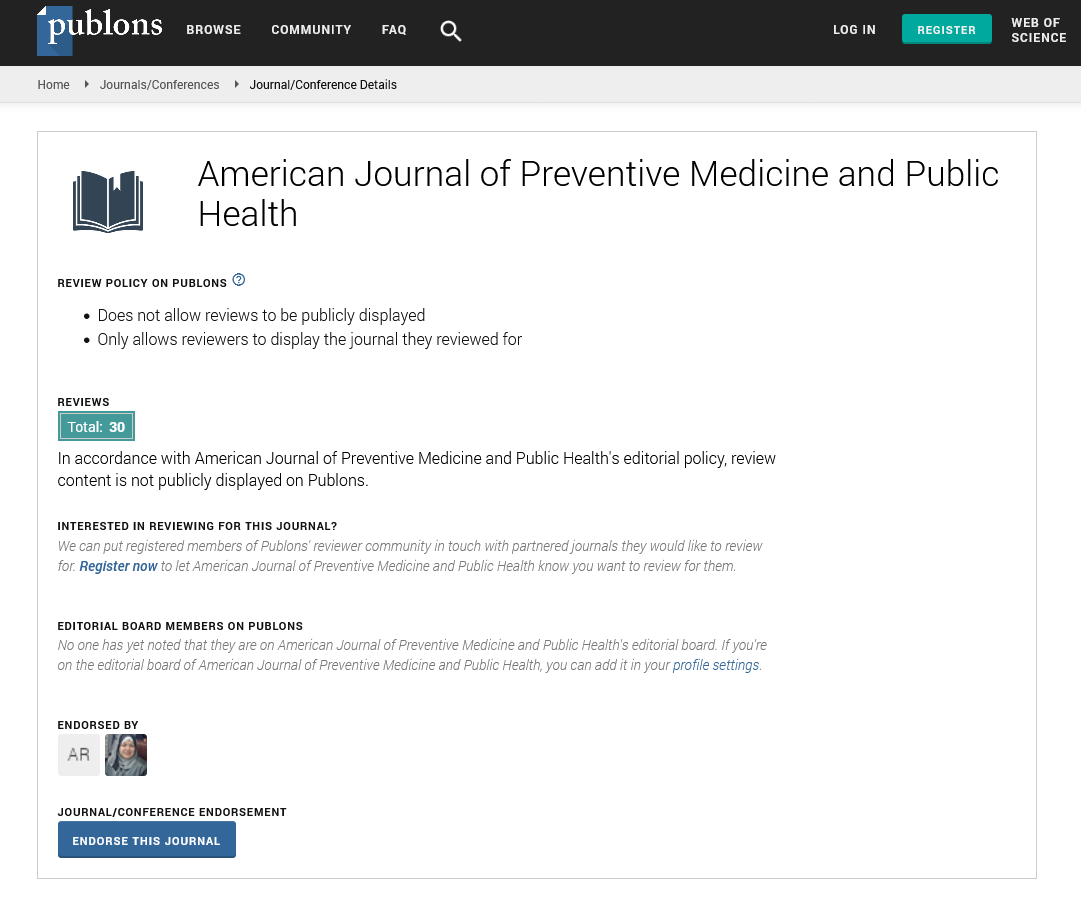Perspective - American Journal of Preventive Medicine and Public Health (2024)
Preventing Childhood Obesity: Public Health Approaches and Practical Measures
Sherin Phares*Sherin Phares, Department of Family Medicine, University of Central Florida, Florida, USA, Email: psher@gmail.com
Received: 21-Jun-2024, Manuscript No. AJPMPH-24-142165; Editor assigned: 24-Jun-2024, Pre QC No. AJPMPH-24-142165 (PQ); Reviewed: 08-Jul-2024, QC No. AJPMPH-24-142165; Revised: 15-Jul-2024, Manuscript No. AJPMPH-24-142165 (R); Published: 22-Jul-2024
Description
Global healthcare is significantly impacted by childhood weight gain issu, with its prevalence having tripled since the 1970s. The World Health Organization (WHO) defines childhood obesity as a condition where a child is significantly overweight for their age and height, usually determined by a Body Mass Index (BMI) at over the 95th percentile in terms of young people and adolescents of the same age and sex. The health implications of childhood obesity are severe and long-lasting, including increased risks of type 2 diabetes, cardiovascular diseases, and psychological issues such as low self-esteem and depression. Combatting this epidemic requires a multifaceted approach that includes preventive measures and comprehensive public health initiatives. This paper explains the root causes of childhood obesity and examines effective strategies to address this critical issue.
Poor eating habits are a major contributing factor to childhood obesity. Consumption of meals high in calories but lacking in nutrients, including fast food and sugary beverages, and snacks, has increased significantly. Children are often subjected to aggressive marketing of unhealthy food options, which can influence their food choices. Additionally, busy family schedules may lead to a reliance on convenience foods that are typically less nutritious. The rise of sedentary lifestyles is another significant factor. Children today spend more time engaging in screen-based activities, such as watching television, playing video games, and using computers or smartphones, rather than participating in physical activities. Schools have also reduced the time allocated to physical education and recess, limiting opportunities for children to be active.
The environment in which children live can significantly impact their health behaviors. Urban areas with limited access to safe parks, playgrounds, and recreational facilities can discourage physical activity. Additionally, food deserts-areas with limited access to affordable and nutritious food-can lead to poor dietary choices.
Socioeconomic Status (SES) plays a critical role in childhood obesity. Lower-income families may face financial barriers to purchasing healthy foods, and parents may lack the time or resources to prepare nutritious meals. Education level can also influence dietary choices and lifestyle habits. To prevent childhood obesity, it is need to promote healthy eating habits from an early age. Parents and caregivers should provide balanced meals that include a variety of fruits, vegetables, whole grains, and lean proteins. Limiting the intake of sugar filled drinks and high-fat, high-sugar snacks is also important . Children can choose healthier foods if they are educated about nutrition and the benefits of having a balanced diet them to make better food choices.
Regular physical activity is vital for maintaining a healthy weight and overall well-being. Schools should ensure that children have ample opportunities for physical exercise through physical education classes, sports programs, and active recess. Communities can support this by providing safe and accessible recreational facilities and organizing family-friendly physical activities. Parents play a significant role in forming their children’s behaviors and attitudes towards food and physical activity. Encouraging family meals, limiting screen time, and promoting active play can help create a healthy home environment. Parenting programs that provide guidance on nutrition and physical activity can also be beneficial. Schools are in a unique position to influence children’s health behaviors. Implementing comprehensive school wellness policies that include healthy meal programs, nutrition education, and regular physical activity can have a significant impact. Schools can also partner with local health organizations to provide resources and support for students and their families.
Public health initiatives
Governments can have a significant impact on combating childhood obesity through policies and regulations. Implementing taxes on sugary beverages, restricting the marketing of unhealthy foods to children, and providing subsidies for healthy foods can help reduce the consumption of high-calorie, low-nutrient foods. Additionally, policies that promote physical activity, such as creating safe walking and biking paths and ensuring access to recreational facilities, can encourage more active lifestyles. Community-based programs can support families in adopting healthier lifestyles. Initiatives such as community gardens, farmers’ markets, and cooking classes can increase access to healthy foods and provide education on nutrition. Physical activity programs, such as sports leagues and fitness classes, can also promote regular exercise.
Healthcare providers, including pediatricians and dietitians, can play a pivotal role in preventing and managing childhood obesity. Regular screening for obesity and related health issues, along with counseling on nutrition and physical activity, can help identify at-risk children and provide early intervention. Providers can also collaborate with schools and community organizations to support broader public health efforts.
Raising awareness about the causes and consequenc es of childhood obesity is fundamental\ for mobiliz ing action. Public health campaigns that highlight the importance of healthy eating and physical ac tivity can influence behaviors and attitudes. Social media and other digital platforms can be leveraged to reach a wide audience and engage communities in dialogue about obesity prevention. The campaign, launched by former First Lady Michelle Obama in 2010, aimed to solve the problem of childhood obesi ty within a generation. The initiative focused on im proving school nutrition, increasing physical activity, and providing information to parents and caregivers. It also promoted public-private partnerships to sup port healthy lifestyles. The campaignâ??s multifaceted approach and high-profile advocacy helped bring na tional attention to the issue of childhood obesity.







